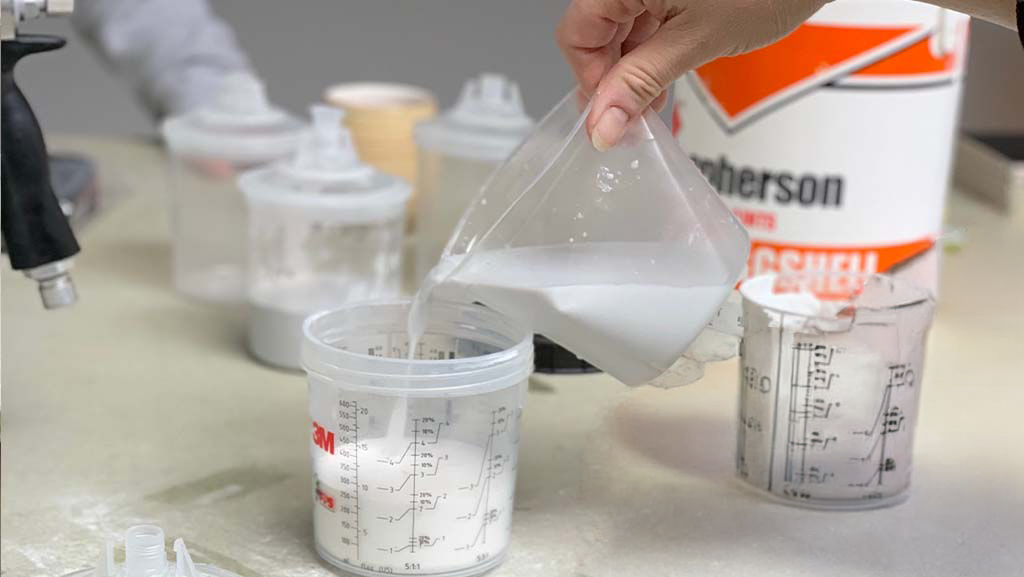If you are new to spraying and painting, then one of the first questions you will ask is how much I thin the paint if I am spraying. We will try and keep it simple here and talk about two types of spray systems and just two types of paint.
The two most commonly used spray systems for decorating are airless sprayers and HVLP (High volume low-pressure sprayers. These two types of sprayers are very different from each other; however, they can both be used to spray paint when decorating your house.
Airless sprayers are very powerful and typically spray paint at around 2000 psi. There is no air involved, and the paint is pumped under pressure through a tiny hole which turns the paint into a mist. Because of this, airless sprayers will spray most things without any thinning at all.
This is one of the significant advantages of airless sprayers; many paints lose some of their qualities when thinned. Having said that, paint falls into two categories.
First, you have emulsion for walls and ceilings, the emulsion will perform well even when thinned, and emulsion will spray better if it is thinned. We would thin emulsion between 10% and 20% depending on the paint brand when spraying finish coats of emulsion. A 10-litre tub of emulsion would have 2 litres of water mixed into it.
You would thin the emulsion more if it were going onto bare plaster. A simple rule of thumb is always thin emulsion before spraying through an airless sprayer, at least by 10%.
Second, you have finish paints for woodwork. Typically, water-based satin these days. When spraying woodwork with satin, you would not thin the paint at all. The airless sprayer would spray neat water-based satin easily, and any thinning could cause problems such as loss of sheen and runs. As a simple rule of thumb, any paint that is being applied to the woodwork by an airless sprayer should not be thinned.
Download Now: The Ultimate Guide To Spraying [Free Template]
High volume low pressure (HVLP) sprayers run at very low pressure, around ten psi. The pressure is provided by a small turbine that sucks air in from the room and compresses it. The compressed air is not stored and is sent directly to the gun.
HVLP systems are slow compared to an airless paint sprayer and would not spray emulsion unless it was a very small area. Emulsion would not spray well through the HVLP and would have to be significantly thinned to get it to spray adequately. You are more likely to be spraying finish paints for woodwork through the HVLP spray gun.
HVLP turbine spray systems are designed to spray thin paints. Many paints are formulated to be sprayed, for example, Tikkurila Akvi primer. Akvi could be sprayed through the HVLP without thinning. However, mist decorative paints are designed to be brushed and rolled and will need to be thinned to go through the HVLP.
A decorative water-based satin that is good to spray is Tikkurila Hemi 10. This would spray through the HVLP with 20% thinning. If you can thin the paintless, then this is an advantage. Thin the paint until it is a single cream consistency.
Unfortunately, some decorative paints spray very poorly, and even with plenty of thinning, they will not spray well. The secret with the HVLP sprayer is to find paints that are designed to be sprayed or that spray well with minimal thinning.
Finally, there are many decorative paints out there, many different brands and many different types of paint. There are primers, undercoats, satins and glosses. There are emulsions and eggshells. While the rules of thumb above work in most cases, it is always worth doing a couple of things if you are using a paint type or brand for the first time.
The first thing to do is look at the datasheet; these can be found these days easily online. Have a look to see if the paint is recommended for spraying and, if so, which types of the sprayer. Also, look to see what the recommended thinning is. If the manufacturer only recommends 10% thinning, then you don’t want to exceed this.
If you are struggling with the datasheet, you can phone the technical department of the particular brand and explain to them that you are spraying the paint. They can then give you specific advice for the particular product you are spraying. If you have read the datasheet as well, this will provide you with reliable information when spraying.





